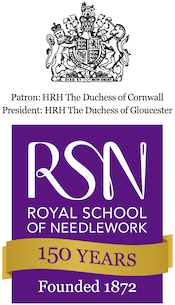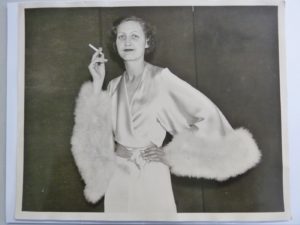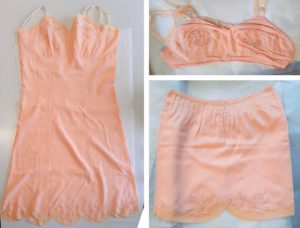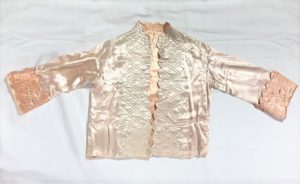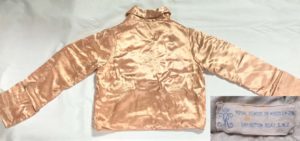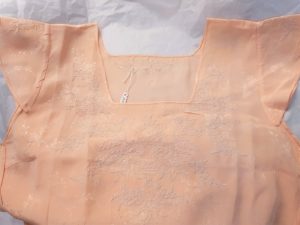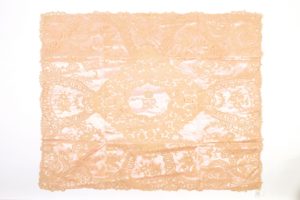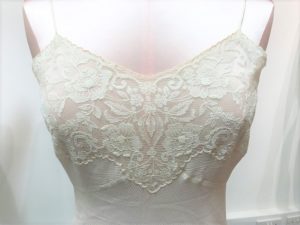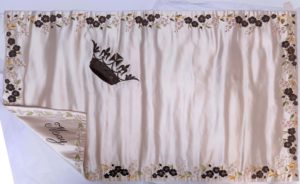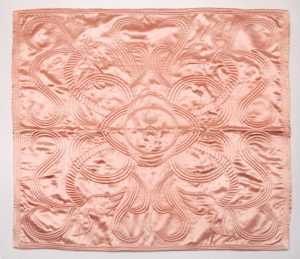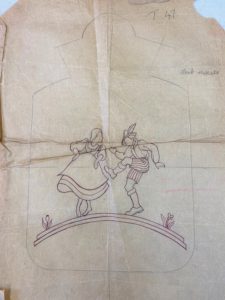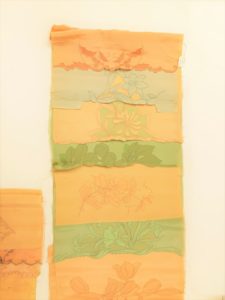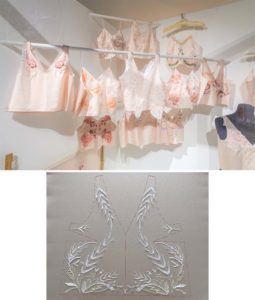Dans la Chambre
I50 Years of the RSN: Virtual Exhibition
The RSN started making lingerie in 1916 and it was an instant hit, even becoming the mainstay of the Workroom during the 1930s when an additional shop space was taken on in Brook Street and eventually also in Davis Street in London’s West End. Clients included royalty and members of high society, and the pinnacle of the work was a wedding trousseau. The RSN embroiderers worked on many of these, including items for the Princess Royal, but the most celebrated set was for Lady Alice Montagu Douglas Scott on her marriage to the Duke of Gloucester in 1935. After the wedding, the trousseau was put on display in London.
In the 1930s the two annual RSN Sales were held in the home of Sir Philip Sassoon on Park Lane, attracting members of the royal family and society women, and revenue from the sales increased substantially over time.
Lady Smith-Dorrien, Principal of the RSN in the 1930s, would make regular trips to Paris to see the latest French designs for lingerie and bring back ideas and materials for them to be created with a British twist. The lingerie department continued into the war years but had to be closed in 1942 as it was no longer viable. The shops had been bombed and materials were not available.
Images of the Lingerie Department and Lingerie Adverts
c1930s
Photographs
In the 1930s under Lady Smith-Dorrien there was a renewed push to promote the lingerie department. As well as the Sales in summer and winter, the RSN had a shop in Brook Street and advertising photographs were taken to show the range of styles available.
Bedjacket
c1930s
Satin
This is one of two bedjackets purchased by Lady Wemyss from the RSN now in the Wemyss collection. Both of the Wemyss jackets contain the RSN’s label which feature the VR monogram. As the lingerie department only began nearly two decades after Queen Victoria died, this shows that the RSN continued to use these labels for many years.
On loan from the Wemyss School of Needlework Collection
Nightdress and Slip
c1930s
Cream silk crepe and lace
These two nightdresses were part of a group of pieces sent to the RSN – all the other pieces are identifiable as from an RSN student and these pieces could be two from the kind of selection Lady Smith Dorrien is setting out in the Sale photograph. It is noticeable that these are cut on the bias which was a common approach of the time.
Throw for Queen Mary
c1890-1910
Silk satin with metal thread embroidery
Before she was Queen, Mary was known to her family as May hence the name on this throw. The metal thread used on the piece has all tarnished but done so consistently so that the piece still looks good. These throws might be used as covers for example, if the maid left out the underclothes for the following day.
Throw for Princess Alice, Duchess of Gloucester
1935
Silk satin hand quilted and sewn
This piece for the trousseau of Lady Alice Montague-Douglas-Scott remained at the RSN and was possibly made as an extra for advertising purposes. It shows the letter A and the crown in the centre and the hand quilting on the piece.
Design for hot water bottle cover
c1930s/40s
Pencil on tracing paper
During the 1930s and especially during the Second World War the RSN was asked to make many hot water bottle covers (always referred to in the workbooks as HWBC). Clients included royalty, Princess Helena Victoria ordering two in 1942.
Samples of Lingerie Colours and Decorations
1930s
Silk and embroidery
These two samplers originated in France, but they show vividly the variety of colours that were popular for lingerie in the 1930s as well as the wide variety of embroidery decorations that could be added to items. These samplers enabled a client to choose their colours and preferred designs very easily, while also being a tempting collection to encourage sales.
New Lingerie
The RSN Degree provides live projects to its students each year, so current second year students were shown some of the lingerie from the 1930s in the RSN Collection and were challenged to create new embroidery based on a camisole top.
Students involved in the project were: Chloe Angrave, Rebecca Ash, Tomas Asmelash, Rowen Bennee, Eliza Burt, Leah Dunham, Kirsty Farrar, Elizabeth Gray, Anfaal Hussain, Alivia Lloyd, Imogen Marmont, Ellie Payne, Jenna Riddell, Chloe Rogers, Freya Stanford, Jessica Wilkinson.
